Wireless Power Transfer Systems: Research and Future Prospects
VerifiedAdded on 2023/06/05
|16
|3379
|295
Report
AI Summary
This report provides a comprehensive analysis of wireless power transfer (WPT) systems, exploring their concepts, applications, and challenges. The report begins with an abstract and literature review, detailing the evolution of WPT technology, including inductive and magnetic resonant coupling methods. It then delves into the challenges faced by WPT systems, such as foreign and live objects (FO/LO) interference and misalignment issues, which can significantly impact power transfer efficiency. The research also poses key questions regarding radiation reduction, misalignment impact, and the potential of WPT in electric vehicles. The significance of the research lies in the development of modular designs to address these challenges. The report further connects the research to the current body of knowledge, highlighting the growing interest in misalignment resilience and FO/LO detection. Finally, the expected outcomes of the research, including improvements in misalignment response and the potential of multi-turn and press-cored loops, are discussed. The report provides detailed figures and equations to support the analysis.
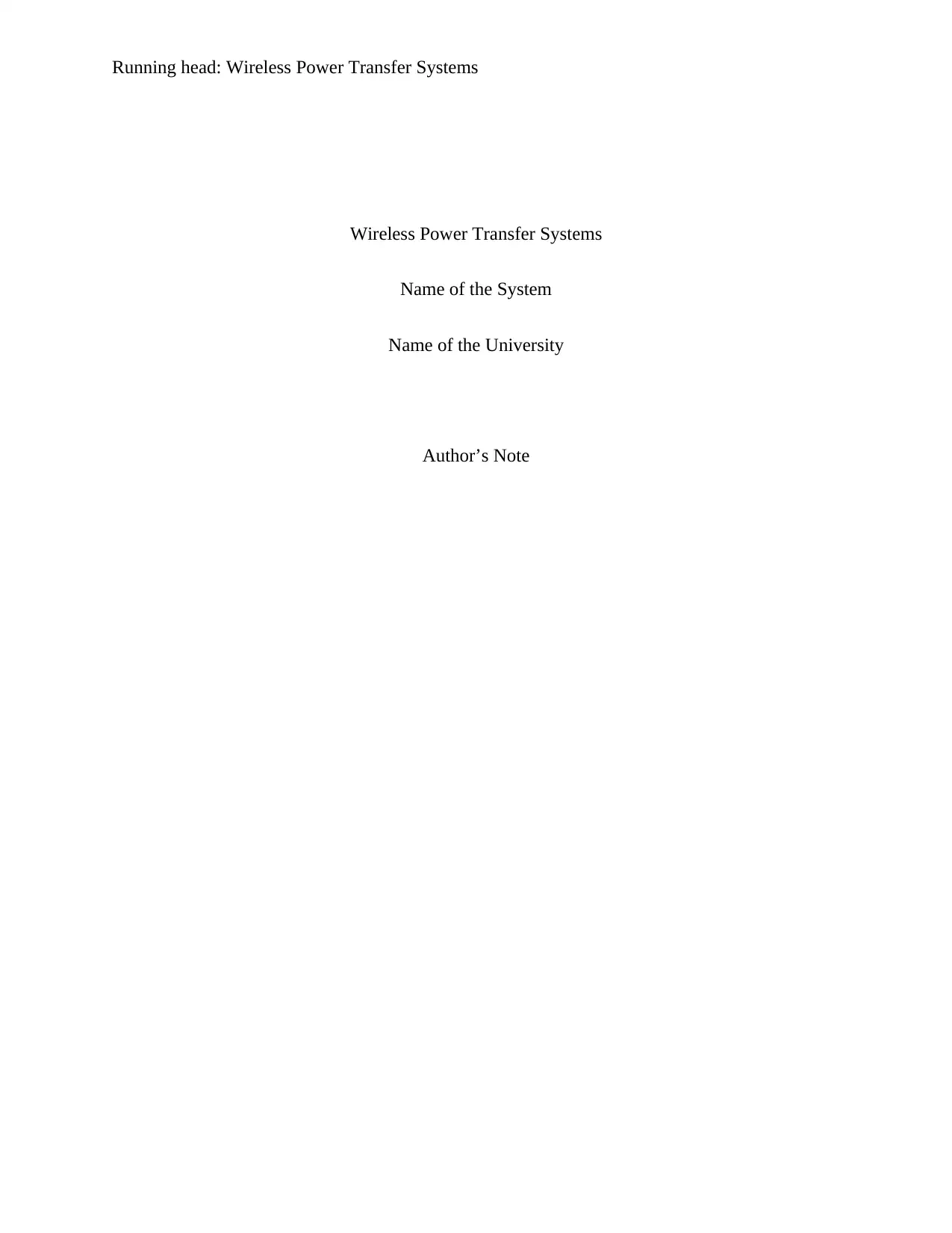
Running head: Wireless Power Transfer Systems
Wireless Power Transfer Systems
Name of the System
Name of the University
Author’s Note
Wireless Power Transfer Systems
Name of the System
Name of the University
Author’s Note
Paraphrase This Document
Need a fresh take? Get an instant paraphrase of this document with our AI Paraphraser
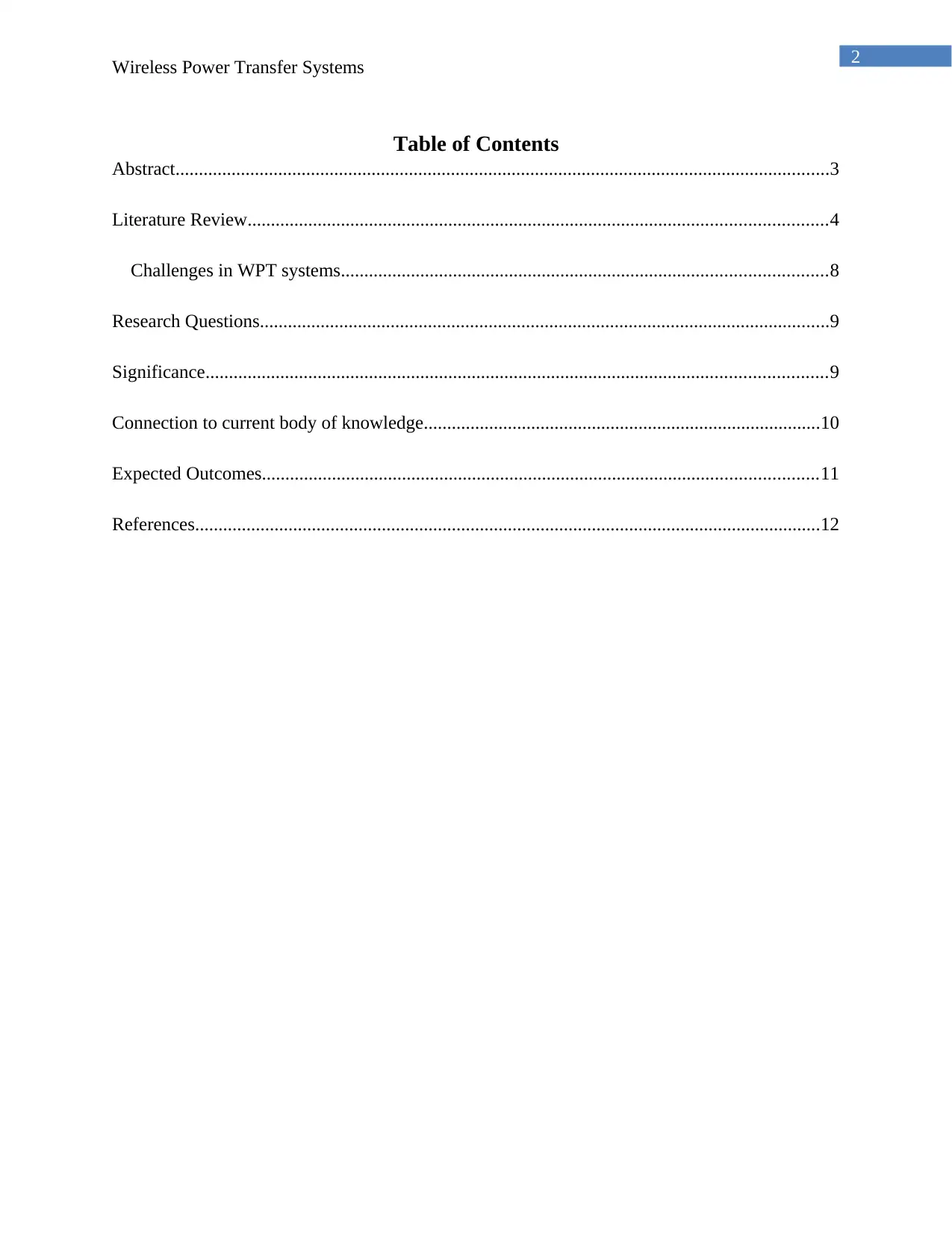
2
Wireless Power Transfer Systems
Table of Contents
Abstract............................................................................................................................................3
Literature Review............................................................................................................................4
Challenges in WPT systems........................................................................................................8
Research Questions..........................................................................................................................9
Significance.....................................................................................................................................9
Connection to current body of knowledge.....................................................................................10
Expected Outcomes.......................................................................................................................11
References......................................................................................................................................12
Wireless Power Transfer Systems
Table of Contents
Abstract............................................................................................................................................3
Literature Review............................................................................................................................4
Challenges in WPT systems........................................................................................................8
Research Questions..........................................................................................................................9
Significance.....................................................................................................................................9
Connection to current body of knowledge.....................................................................................10
Expected Outcomes.......................................................................................................................11
References......................................................................................................................................12
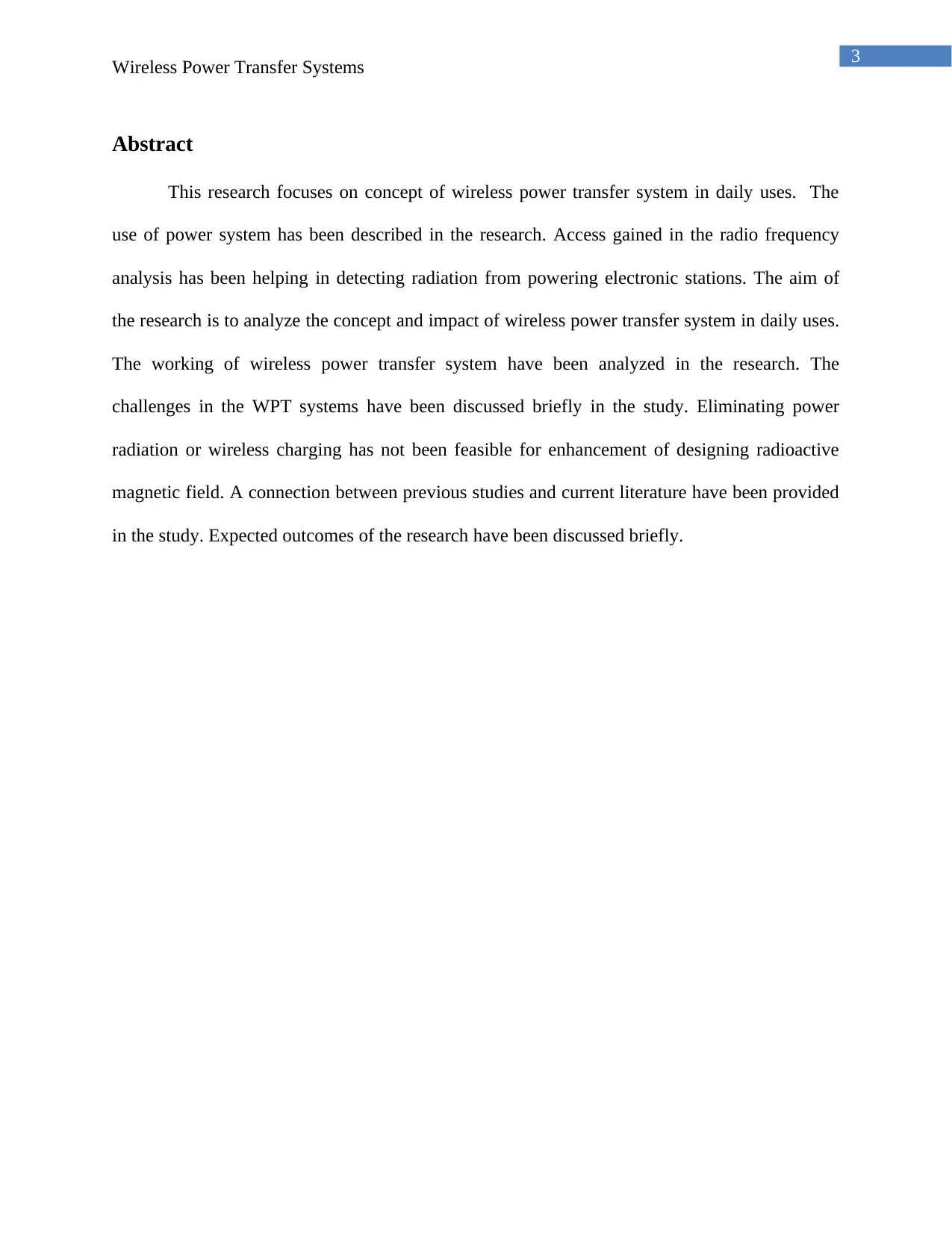
3
Wireless Power Transfer Systems
Abstract
This research focuses on concept of wireless power transfer system in daily uses. The
use of power system has been described in the research. Access gained in the radio frequency
analysis has been helping in detecting radiation from powering electronic stations. The aim of
the research is to analyze the concept and impact of wireless power transfer system in daily uses.
The working of wireless power transfer system have been analyzed in the research. The
challenges in the WPT systems have been discussed briefly in the study. Eliminating power
radiation or wireless charging has not been feasible for enhancement of designing radioactive
magnetic field. A connection between previous studies and current literature have been provided
in the study. Expected outcomes of the research have been discussed briefly.
Wireless Power Transfer Systems
Abstract
This research focuses on concept of wireless power transfer system in daily uses. The
use of power system has been described in the research. Access gained in the radio frequency
analysis has been helping in detecting radiation from powering electronic stations. The aim of
the research is to analyze the concept and impact of wireless power transfer system in daily uses.
The working of wireless power transfer system have been analyzed in the research. The
challenges in the WPT systems have been discussed briefly in the study. Eliminating power
radiation or wireless charging has not been feasible for enhancement of designing radioactive
magnetic field. A connection between previous studies and current literature have been provided
in the study. Expected outcomes of the research have been discussed briefly.
⊘ This is a preview!⊘
Do you want full access?
Subscribe today to unlock all pages.

Trusted by 1+ million students worldwide
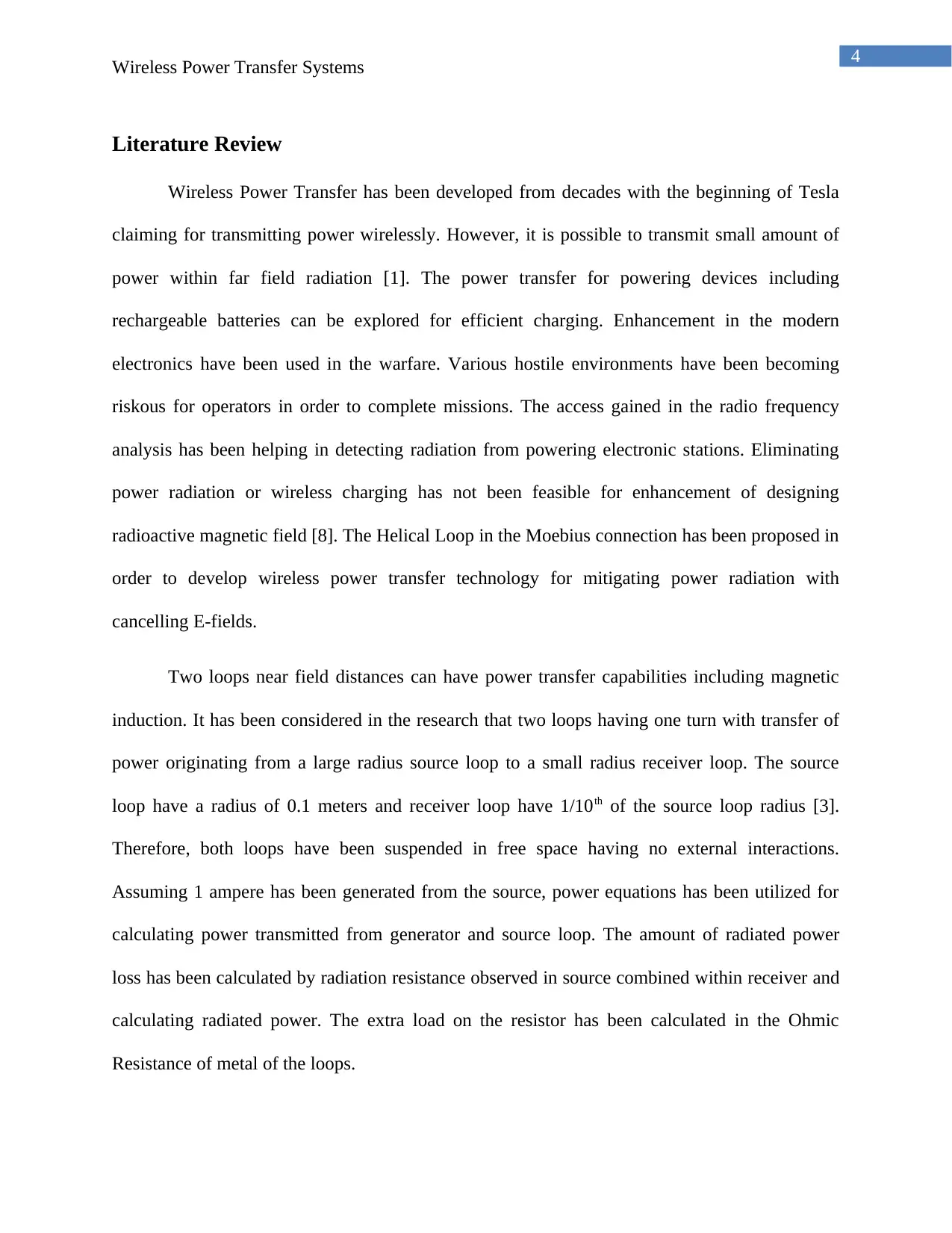
4
Wireless Power Transfer Systems
Literature Review
Wireless Power Transfer has been developed from decades with the beginning of Tesla
claiming for transmitting power wirelessly. However, it is possible to transmit small amount of
power within far field radiation [1]. The power transfer for powering devices including
rechargeable batteries can be explored for efficient charging. Enhancement in the modern
electronics have been used in the warfare. Various hostile environments have been becoming
riskous for operators in order to complete missions. The access gained in the radio frequency
analysis has been helping in detecting radiation from powering electronic stations. Eliminating
power radiation or wireless charging has not been feasible for enhancement of designing
radioactive magnetic field [8]. The Helical Loop in the Moebius connection has been proposed in
order to develop wireless power transfer technology for mitigating power radiation with
cancelling E-fields.
Two loops near field distances can have power transfer capabilities including magnetic
induction. It has been considered in the research that two loops having one turn with transfer of
power originating from a large radius source loop to a small radius receiver loop. The source
loop have a radius of 0.1 meters and receiver loop have 1/10th of the source loop radius [3].
Therefore, both loops have been suspended in free space having no external interactions.
Assuming 1 ampere has been generated from the source, power equations has been utilized for
calculating power transmitted from generator and source loop. The amount of radiated power
loss has been calculated by radiation resistance observed in source combined within receiver and
calculating radiated power. The extra load on the resistor has been calculated in the Ohmic
Resistance of metal of the loops.
Wireless Power Transfer Systems
Literature Review
Wireless Power Transfer has been developed from decades with the beginning of Tesla
claiming for transmitting power wirelessly. However, it is possible to transmit small amount of
power within far field radiation [1]. The power transfer for powering devices including
rechargeable batteries can be explored for efficient charging. Enhancement in the modern
electronics have been used in the warfare. Various hostile environments have been becoming
riskous for operators in order to complete missions. The access gained in the radio frequency
analysis has been helping in detecting radiation from powering electronic stations. Eliminating
power radiation or wireless charging has not been feasible for enhancement of designing
radioactive magnetic field [8]. The Helical Loop in the Moebius connection has been proposed in
order to develop wireless power transfer technology for mitigating power radiation with
cancelling E-fields.
Two loops near field distances can have power transfer capabilities including magnetic
induction. It has been considered in the research that two loops having one turn with transfer of
power originating from a large radius source loop to a small radius receiver loop. The source
loop have a radius of 0.1 meters and receiver loop have 1/10th of the source loop radius [3].
Therefore, both loops have been suspended in free space having no external interactions.
Assuming 1 ampere has been generated from the source, power equations has been utilized for
calculating power transmitted from generator and source loop. The amount of radiated power
loss has been calculated by radiation resistance observed in source combined within receiver and
calculating radiated power. The extra load on the resistor has been calculated in the Ohmic
Resistance of metal of the loops.
Paraphrase This Document
Need a fresh take? Get an instant paraphrase of this document with our AI Paraphraser
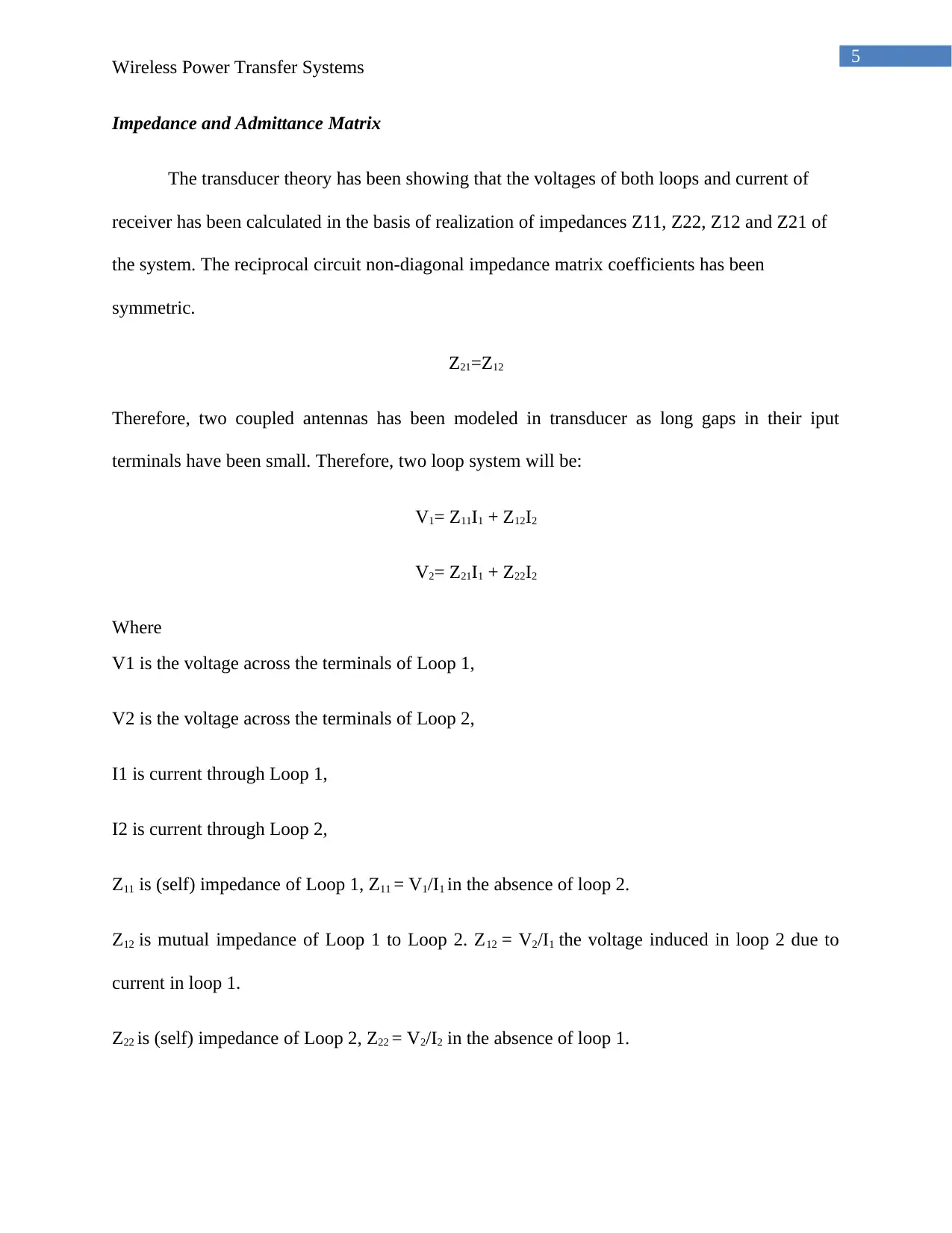
5
Wireless Power Transfer Systems
Impedance and Admittance Matrix
The transducer theory has been showing that the voltages of both loops and current of
receiver has been calculated in the basis of realization of impedances Z11, Z22, Z12 and Z21 of
the system. The reciprocal circuit non-diagonal impedance matrix coefficients has been
symmetric.
Z21=Z12
Therefore, two coupled antennas has been modeled in transducer as long gaps in their iput
terminals have been small. Therefore, two loop system will be:
V1= Z11I1 + Z12I2
V2= Z21I1 + Z22I2
Where
V1 is the voltage across the terminals of Loop 1,
V2 is the voltage across the terminals of Loop 2,
I1 is current through Loop 1,
I2 is current through Loop 2,
Z11 is (self) impedance of Loop 1, Z11 = V1/I1 in the absence of loop 2.
Z12 is mutual impedance of Loop 1 to Loop 2. Z12 = V2/I1 the voltage induced in loop 2 due to
current in loop 1.
Z22 is (self) impedance of Loop 2, Z22 = V2/I2 in the absence of loop 1.
Wireless Power Transfer Systems
Impedance and Admittance Matrix
The transducer theory has been showing that the voltages of both loops and current of
receiver has been calculated in the basis of realization of impedances Z11, Z22, Z12 and Z21 of
the system. The reciprocal circuit non-diagonal impedance matrix coefficients has been
symmetric.
Z21=Z12
Therefore, two coupled antennas has been modeled in transducer as long gaps in their iput
terminals have been small. Therefore, two loop system will be:
V1= Z11I1 + Z12I2
V2= Z21I1 + Z22I2
Where
V1 is the voltage across the terminals of Loop 1,
V2 is the voltage across the terminals of Loop 2,
I1 is current through Loop 1,
I2 is current through Loop 2,
Z11 is (self) impedance of Loop 1, Z11 = V1/I1 in the absence of loop 2.
Z12 is mutual impedance of Loop 1 to Loop 2. Z12 = V2/I1 the voltage induced in loop 2 due to
current in loop 1.
Z22 is (self) impedance of Loop 2, Z22 = V2/I2 in the absence of loop 1.
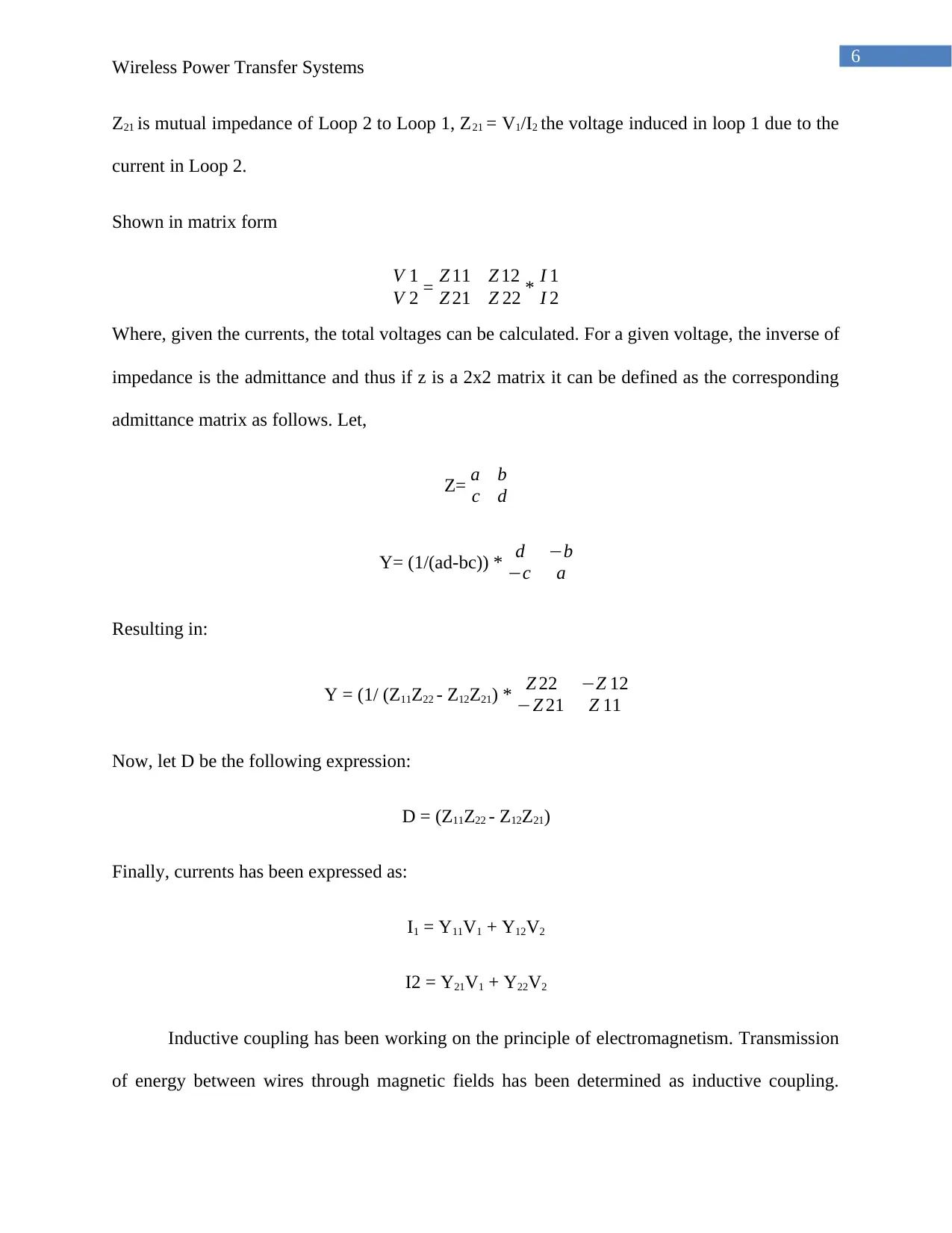
6
Wireless Power Transfer Systems
Z21 is mutual impedance of Loop 2 to Loop 1, Z21 = V1/I2 the voltage induced in loop 1 due to the
current in Loop 2.
Shown in matrix form
V 1
V 2 = Z 11 Z 12
Z 21 Z 22 * I 1
I 2
Where, given the currents, the total voltages can be calculated. For a given voltage, the inverse of
impedance is the admittance and thus if z is a 2x2 matrix it can be defined as the corresponding
admittance matrix as follows. Let,
Z= a b
c d
Y= (1/(ad-bc)) * d −b
−c a
Resulting in:
Y = (1/ (Z11Z22 - Z12Z21) * Z 22 −Z 12
−Z 21 Z 11
Now, let D be the following expression:
D = (Z11Z22 - Z12Z21)
Finally, currents has been expressed as:
I1 = Y11V1 + Y12V2
I2 = Y21V1 + Y22V2
Inductive coupling has been working on the principle of electromagnetism. Transmission
of energy between wires through magnetic fields has been determined as inductive coupling.
Wireless Power Transfer Systems
Z21 is mutual impedance of Loop 2 to Loop 1, Z21 = V1/I2 the voltage induced in loop 1 due to the
current in Loop 2.
Shown in matrix form
V 1
V 2 = Z 11 Z 12
Z 21 Z 22 * I 1
I 2
Where, given the currents, the total voltages can be calculated. For a given voltage, the inverse of
impedance is the admittance and thus if z is a 2x2 matrix it can be defined as the corresponding
admittance matrix as follows. Let,
Z= a b
c d
Y= (1/(ad-bc)) * d −b
−c a
Resulting in:
Y = (1/ (Z11Z22 - Z12Z21) * Z 22 −Z 12
−Z 21 Z 11
Now, let D be the following expression:
D = (Z11Z22 - Z12Z21)
Finally, currents has been expressed as:
I1 = Y11V1 + Y12V2
I2 = Y21V1 + Y22V2
Inductive coupling has been working on the principle of electromagnetism. Transmission
of energy between wires through magnetic fields has been determined as inductive coupling.
⊘ This is a preview!⊘
Do you want full access?
Subscribe today to unlock all pages.

Trusted by 1+ million students worldwide
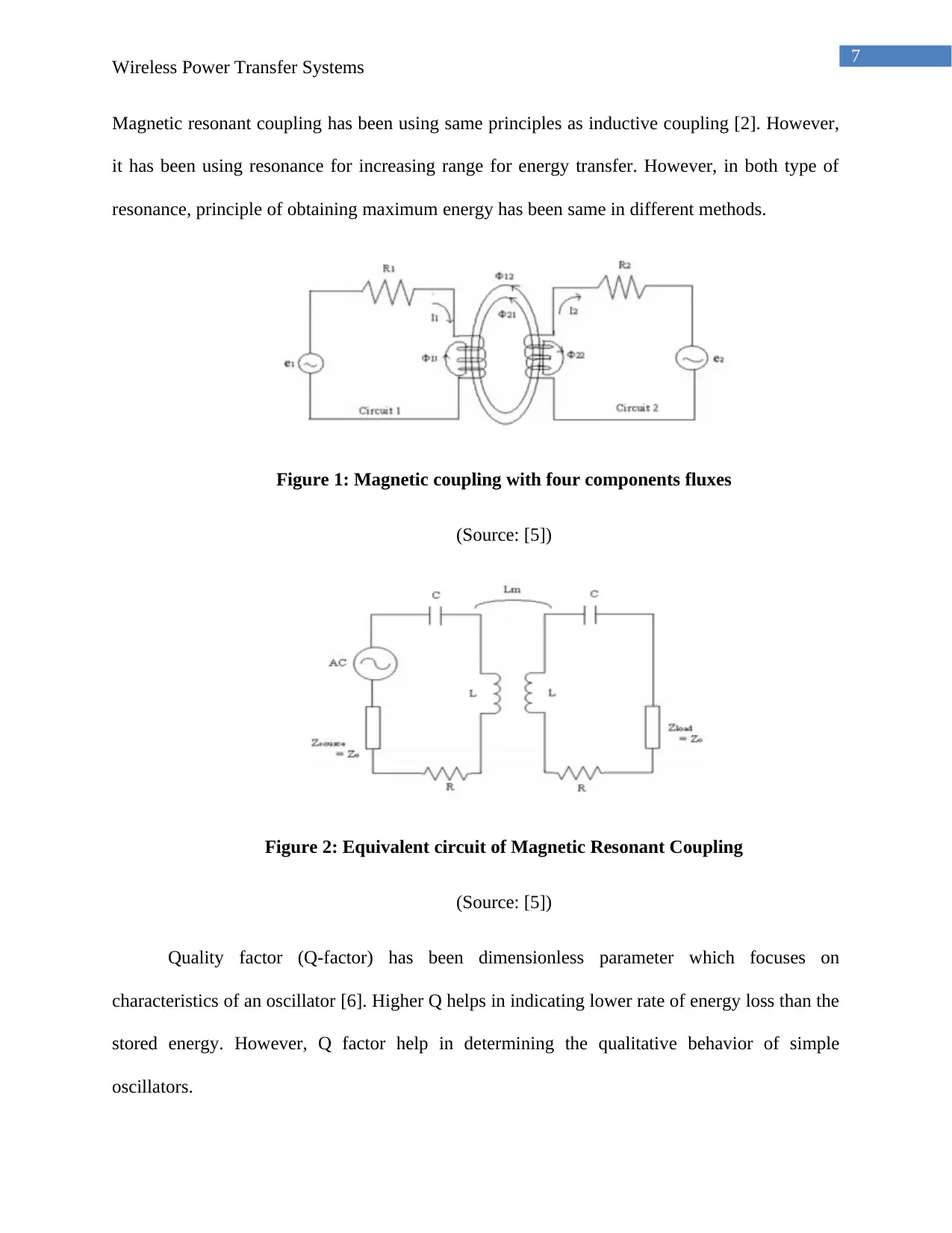
7
Wireless Power Transfer Systems
Magnetic resonant coupling has been using same principles as inductive coupling [2]. However,
it has been using resonance for increasing range for energy transfer. However, in both type of
resonance, principle of obtaining maximum energy has been same in different methods.
Figure 1: Magnetic coupling with four components fluxes
(Source: [5])
Figure 2: Equivalent circuit of Magnetic Resonant Coupling
(Source: [5])
Quality factor (Q-factor) has been dimensionless parameter which focuses on
characteristics of an oscillator [6]. Higher Q helps in indicating lower rate of energy loss than the
stored energy. However, Q factor help in determining the qualitative behavior of simple
oscillators.
Wireless Power Transfer Systems
Magnetic resonant coupling has been using same principles as inductive coupling [2]. However,
it has been using resonance for increasing range for energy transfer. However, in both type of
resonance, principle of obtaining maximum energy has been same in different methods.
Figure 1: Magnetic coupling with four components fluxes
(Source: [5])
Figure 2: Equivalent circuit of Magnetic Resonant Coupling
(Source: [5])
Quality factor (Q-factor) has been dimensionless parameter which focuses on
characteristics of an oscillator [6]. Higher Q helps in indicating lower rate of energy loss than the
stored energy. However, Q factor help in determining the qualitative behavior of simple
oscillators.
Paraphrase This Document
Need a fresh take? Get an instant paraphrase of this document with our AI Paraphraser
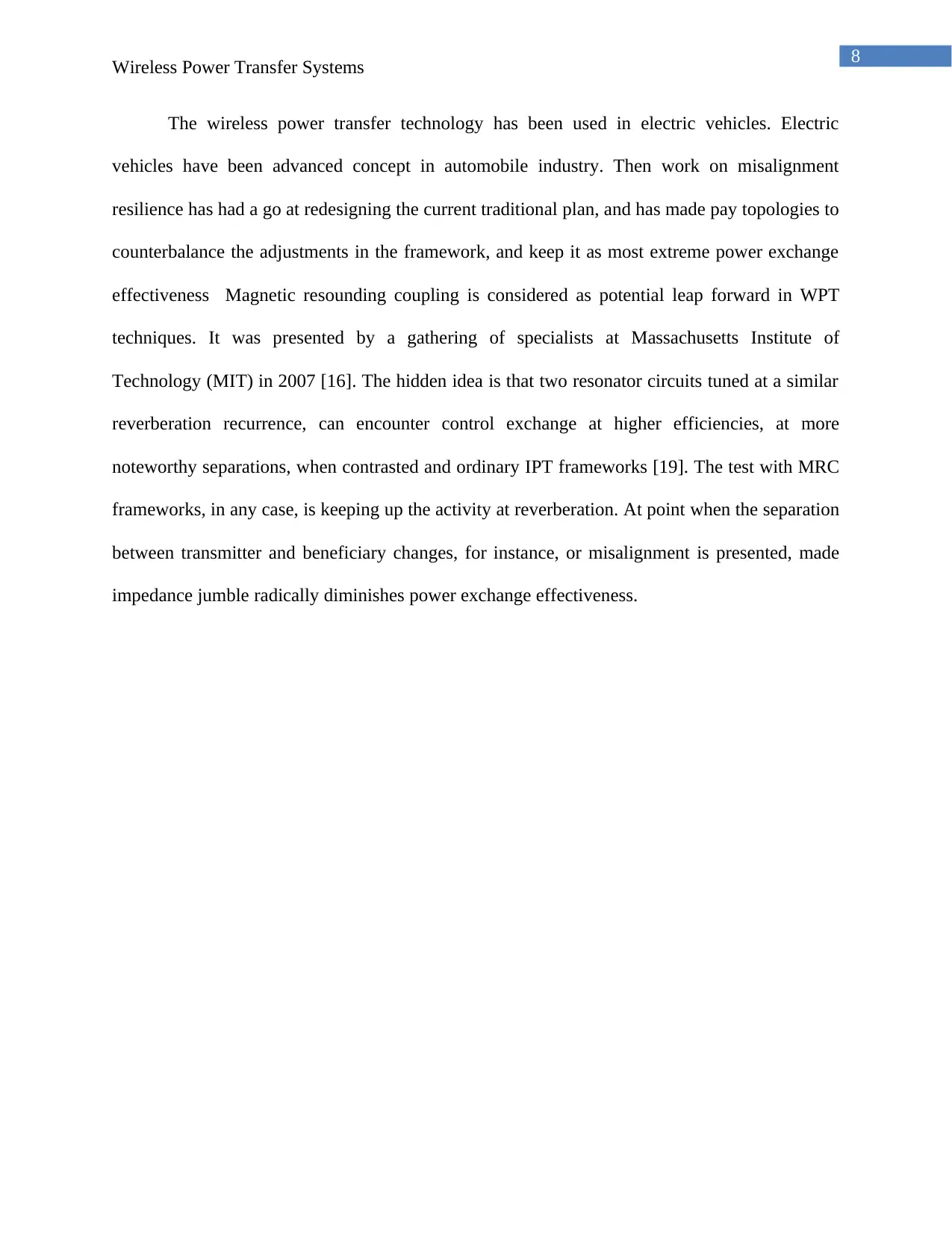
8
Wireless Power Transfer Systems
The wireless power transfer technology has been used in electric vehicles. Electric
vehicles have been advanced concept in automobile industry. Then work on misalignment
resilience has had a go at redesigning the current traditional plan, and has made pay topologies to
counterbalance the adjustments in the framework, and keep it as most extreme power exchange
effectiveness Magnetic resounding coupling is considered as potential leap forward in WPT
techniques. It was presented by a gathering of specialists at Massachusetts Institute of
Technology (MIT) in 2007 [16]. The hidden idea is that two resonator circuits tuned at a similar
reverberation recurrence, can encounter control exchange at higher efficiencies, at more
noteworthy separations, when contrasted and ordinary IPT frameworks [19]. The test with MRC
frameworks, in any case, is keeping up the activity at reverberation. At point when the separation
between transmitter and beneficiary changes, for instance, or misalignment is presented, made
impedance jumble radically diminishes power exchange effectiveness.
Wireless Power Transfer Systems
The wireless power transfer technology has been used in electric vehicles. Electric
vehicles have been advanced concept in automobile industry. Then work on misalignment
resilience has had a go at redesigning the current traditional plan, and has made pay topologies to
counterbalance the adjustments in the framework, and keep it as most extreme power exchange
effectiveness Magnetic resounding coupling is considered as potential leap forward in WPT
techniques. It was presented by a gathering of specialists at Massachusetts Institute of
Technology (MIT) in 2007 [16]. The hidden idea is that two resonator circuits tuned at a similar
reverberation recurrence, can encounter control exchange at higher efficiencies, at more
noteworthy separations, when contrasted and ordinary IPT frameworks [19]. The test with MRC
frameworks, in any case, is keeping up the activity at reverberation. At point when the separation
between transmitter and beneficiary changes, for instance, or misalignment is presented, made
impedance jumble radically diminishes power exchange effectiveness.
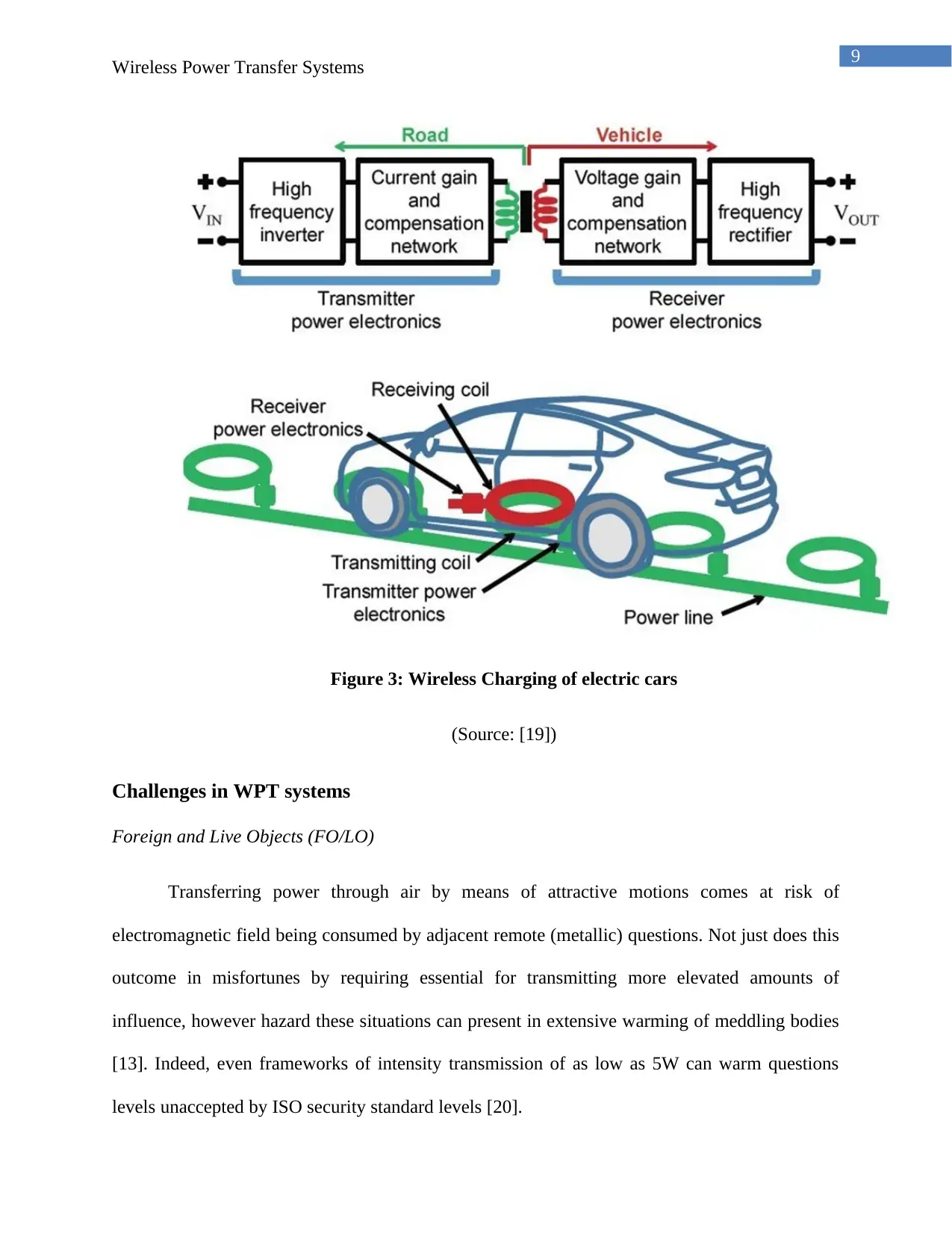
9
Wireless Power Transfer Systems
Figure 3: Wireless Charging of electric cars
(Source: [19])
Challenges in WPT systems
Foreign and Live Objects (FO/LO)
Transferring power through air by means of attractive motions comes at risk of
electromagnetic field being consumed by adjacent remote (metallic) questions. Not just does this
outcome in misfortunes by requiring essential for transmitting more elevated amounts of
influence, however hazard these situations can present in extensive warming of meddling bodies
[13]. Indeed, even frameworks of intensity transmission of as low as 5W can warm questions
levels unaccepted by ISO security standard levels [20].
Wireless Power Transfer Systems
Figure 3: Wireless Charging of electric cars
(Source: [19])
Challenges in WPT systems
Foreign and Live Objects (FO/LO)
Transferring power through air by means of attractive motions comes at risk of
electromagnetic field being consumed by adjacent remote (metallic) questions. Not just does this
outcome in misfortunes by requiring essential for transmitting more elevated amounts of
influence, however hazard these situations can present in extensive warming of meddling bodies
[13]. Indeed, even frameworks of intensity transmission of as low as 5W can warm questions
levels unaccepted by ISO security standard levels [20].
⊘ This is a preview!⊘
Do you want full access?
Subscribe today to unlock all pages.

Trusted by 1+ million students worldwide
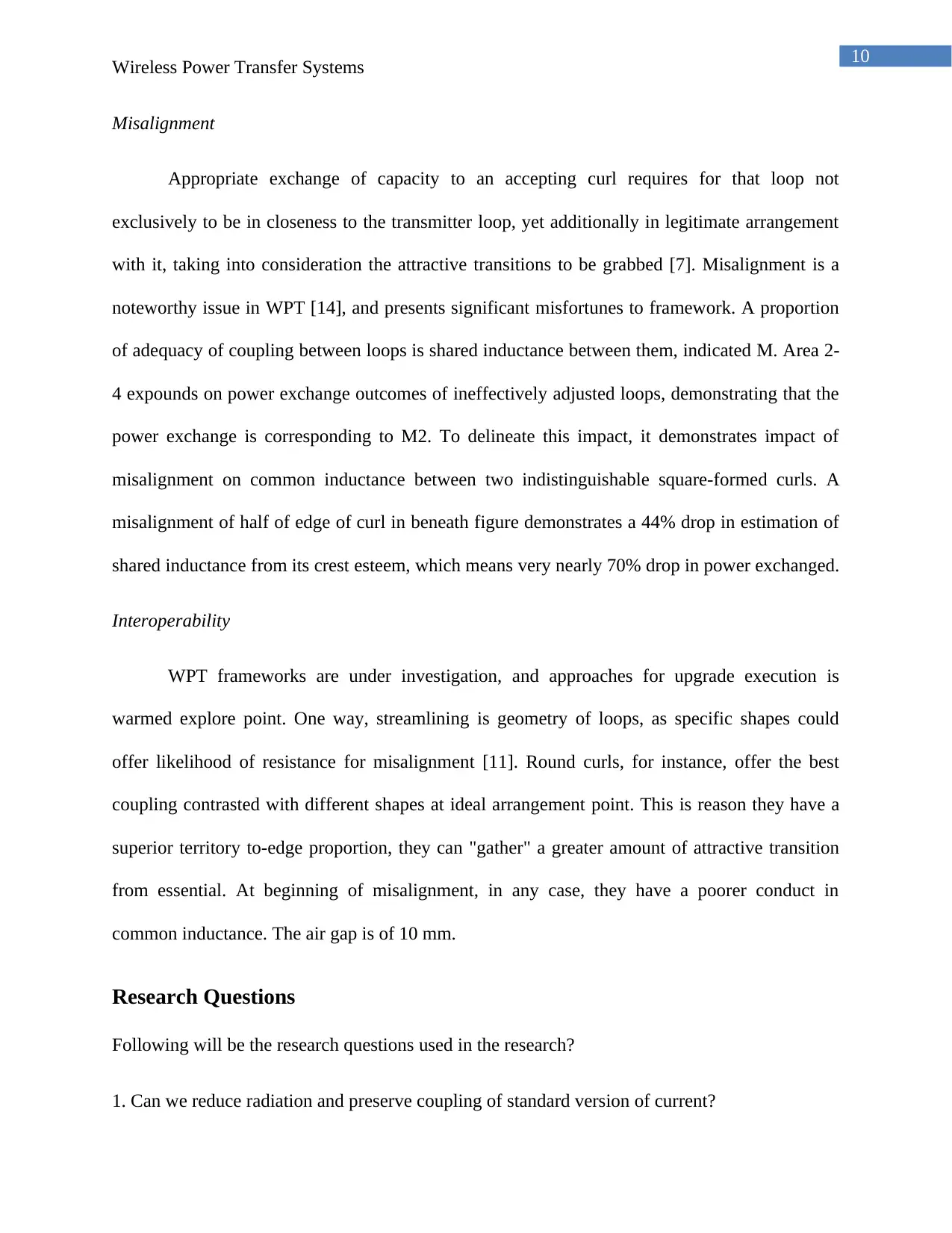
10
Wireless Power Transfer Systems
Misalignment
Appropriate exchange of capacity to an accepting curl requires for that loop not
exclusively to be in closeness to the transmitter loop, yet additionally in legitimate arrangement
with it, taking into consideration the attractive transitions to be grabbed [7]. Misalignment is a
noteworthy issue in WPT [14], and presents significant misfortunes to framework. A proportion
of adequacy of coupling between loops is shared inductance between them, indicated M. Area 2-
4 expounds on power exchange outcomes of ineffectively adjusted loops, demonstrating that the
power exchange is corresponding to M2. To delineate this impact, it demonstrates impact of
misalignment on common inductance between two indistinguishable square-formed curls. A
misalignment of half of edge of curl in beneath figure demonstrates a 44% drop in estimation of
shared inductance from its crest esteem, which means very nearly 70% drop in power exchanged.
Interoperability
WPT frameworks are under investigation, and approaches for upgrade execution is
warmed explore point. One way, streamlining is geometry of loops, as specific shapes could
offer likelihood of resistance for misalignment [11]. Round curls, for instance, offer the best
coupling contrasted with different shapes at ideal arrangement point. This is reason they have a
superior territory to-edge proportion, they can "gather" a greater amount of attractive transition
from essential. At beginning of misalignment, in any case, they have a poorer conduct in
common inductance. The air gap is of 10 mm.
Research Questions
Following will be the research questions used in the research?
1. Can we reduce radiation and preserve coupling of standard version of current?
Wireless Power Transfer Systems
Misalignment
Appropriate exchange of capacity to an accepting curl requires for that loop not
exclusively to be in closeness to the transmitter loop, yet additionally in legitimate arrangement
with it, taking into consideration the attractive transitions to be grabbed [7]. Misalignment is a
noteworthy issue in WPT [14], and presents significant misfortunes to framework. A proportion
of adequacy of coupling between loops is shared inductance between them, indicated M. Area 2-
4 expounds on power exchange outcomes of ineffectively adjusted loops, demonstrating that the
power exchange is corresponding to M2. To delineate this impact, it demonstrates impact of
misalignment on common inductance between two indistinguishable square-formed curls. A
misalignment of half of edge of curl in beneath figure demonstrates a 44% drop in estimation of
shared inductance from its crest esteem, which means very nearly 70% drop in power exchanged.
Interoperability
WPT frameworks are under investigation, and approaches for upgrade execution is
warmed explore point. One way, streamlining is geometry of loops, as specific shapes could
offer likelihood of resistance for misalignment [11]. Round curls, for instance, offer the best
coupling contrasted with different shapes at ideal arrangement point. This is reason they have a
superior territory to-edge proportion, they can "gather" a greater amount of attractive transition
from essential. At beginning of misalignment, in any case, they have a poorer conduct in
common inductance. The air gap is of 10 mm.
Research Questions
Following will be the research questions used in the research?
1. Can we reduce radiation and preserve coupling of standard version of current?
Paraphrase This Document
Need a fresh take? Get an instant paraphrase of this document with our AI Paraphraser
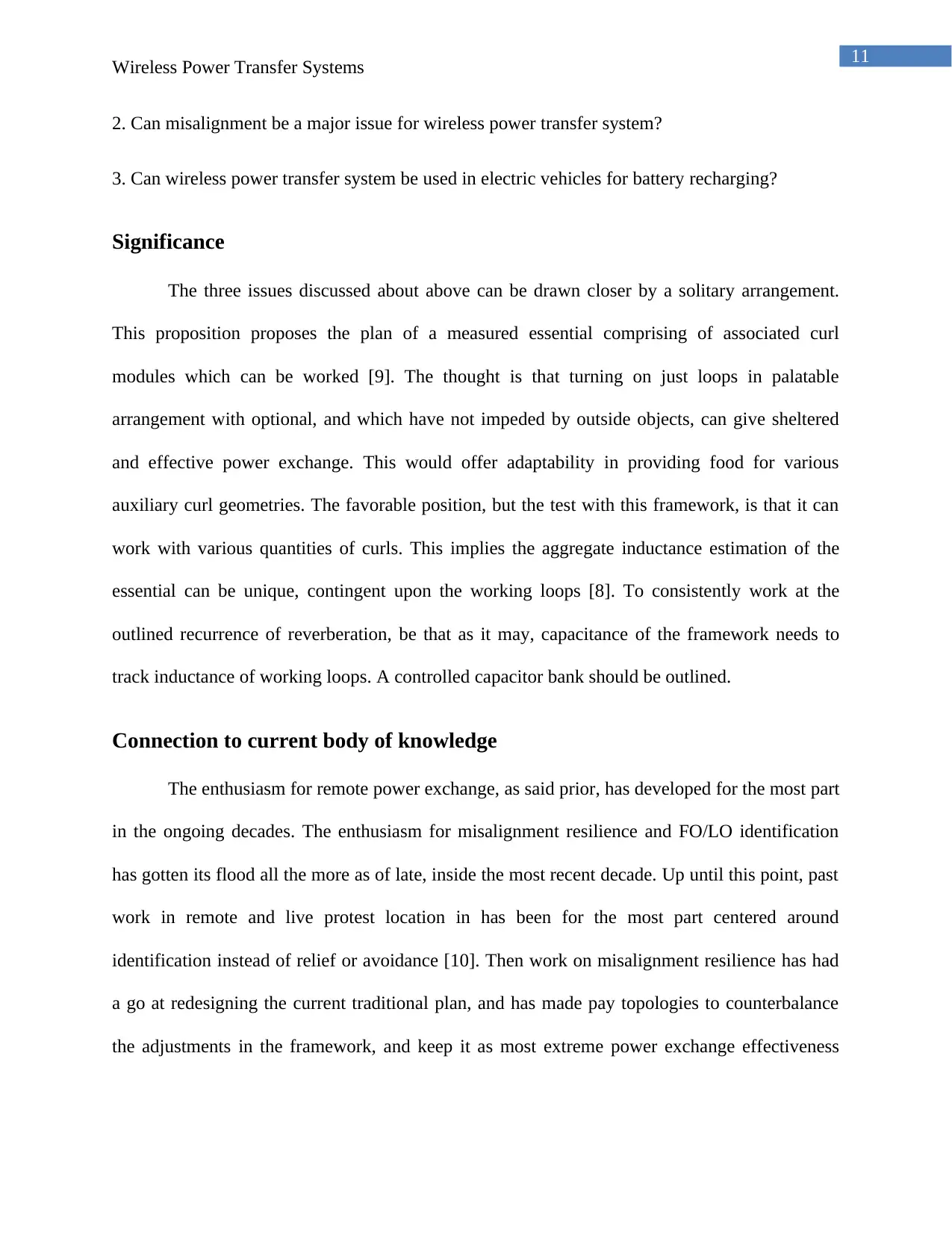
11
Wireless Power Transfer Systems
2. Can misalignment be a major issue for wireless power transfer system?
3. Can wireless power transfer system be used in electric vehicles for battery recharging?
Significance
The three issues discussed about above can be drawn closer by a solitary arrangement.
This proposition proposes the plan of a measured essential comprising of associated curl
modules which can be worked [9]. The thought is that turning on just loops in palatable
arrangement with optional, and which have not impeded by outside objects, can give sheltered
and effective power exchange. This would offer adaptability in providing food for various
auxiliary curl geometries. The favorable position, but the test with this framework, is that it can
work with various quantities of curls. This implies the aggregate inductance estimation of the
essential can be unique, contingent upon the working loops [8]. To consistently work at the
outlined recurrence of reverberation, be that as it may, capacitance of the framework needs to
track inductance of working loops. A controlled capacitor bank should be outlined.
Connection to current body of knowledge
The enthusiasm for remote power exchange, as said prior, has developed for the most part
in the ongoing decades. The enthusiasm for misalignment resilience and FO/LO identification
has gotten its flood all the more as of late, inside the most recent decade. Up until this point, past
work in remote and live protest location in has been for the most part centered around
identification instead of relief or avoidance [10]. Then work on misalignment resilience has had
a go at redesigning the current traditional plan, and has made pay topologies to counterbalance
the adjustments in the framework, and keep it as most extreme power exchange effectiveness
Wireless Power Transfer Systems
2. Can misalignment be a major issue for wireless power transfer system?
3. Can wireless power transfer system be used in electric vehicles for battery recharging?
Significance
The three issues discussed about above can be drawn closer by a solitary arrangement.
This proposition proposes the plan of a measured essential comprising of associated curl
modules which can be worked [9]. The thought is that turning on just loops in palatable
arrangement with optional, and which have not impeded by outside objects, can give sheltered
and effective power exchange. This would offer adaptability in providing food for various
auxiliary curl geometries. The favorable position, but the test with this framework, is that it can
work with various quantities of curls. This implies the aggregate inductance estimation of the
essential can be unique, contingent upon the working loops [8]. To consistently work at the
outlined recurrence of reverberation, be that as it may, capacitance of the framework needs to
track inductance of working loops. A controlled capacitor bank should be outlined.
Connection to current body of knowledge
The enthusiasm for remote power exchange, as said prior, has developed for the most part
in the ongoing decades. The enthusiasm for misalignment resilience and FO/LO identification
has gotten its flood all the more as of late, inside the most recent decade. Up until this point, past
work in remote and live protest location in has been for the most part centered around
identification instead of relief or avoidance [10]. Then work on misalignment resilience has had
a go at redesigning the current traditional plan, and has made pay topologies to counterbalance
the adjustments in the framework, and keep it as most extreme power exchange effectiveness
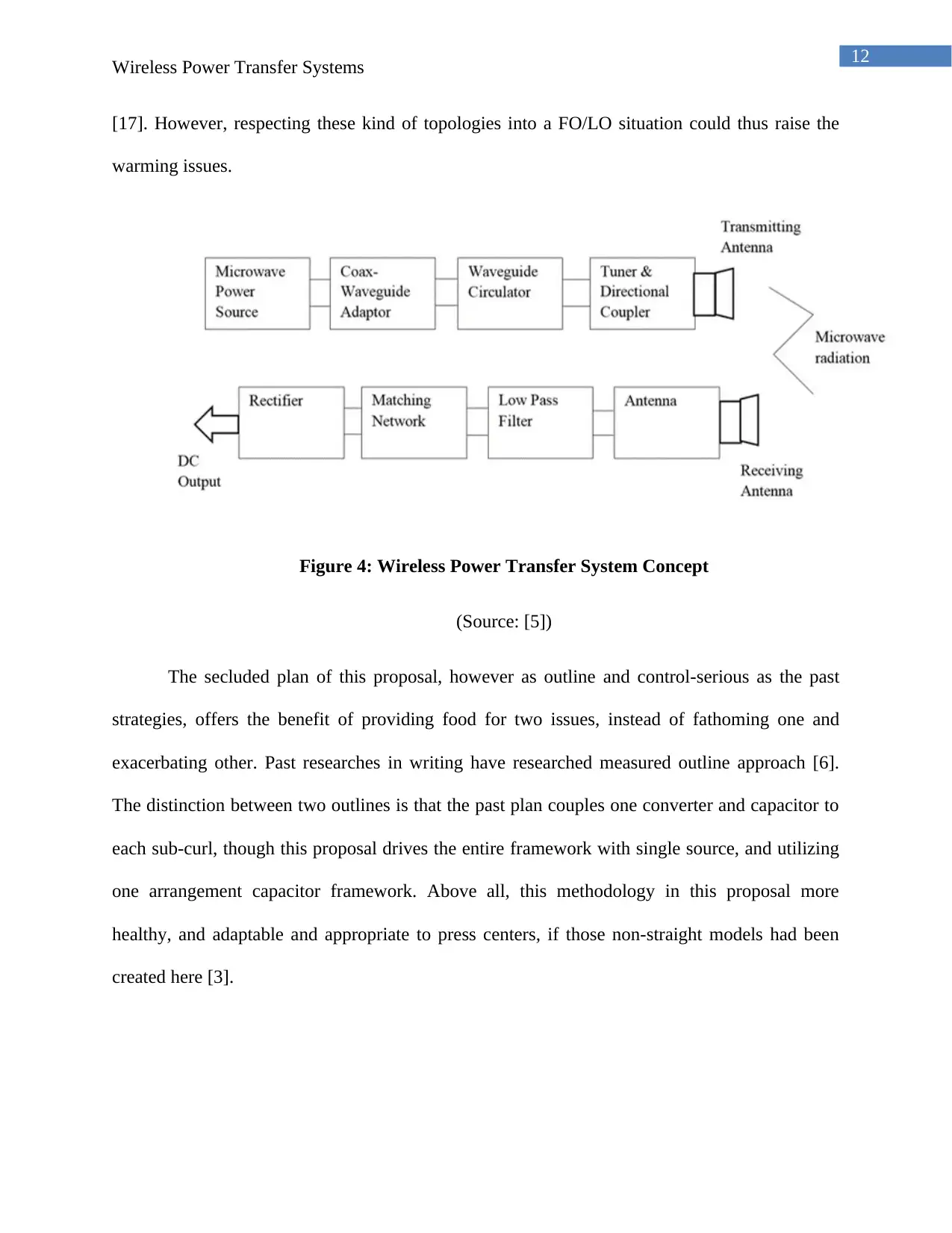
12
Wireless Power Transfer Systems
[17]. However, respecting these kind of topologies into a FO/LO situation could thus raise the
warming issues.
Figure 4: Wireless Power Transfer System Concept
(Source: [5])
The secluded plan of this proposal, however as outline and control-serious as the past
strategies, offers the benefit of providing food for two issues, instead of fathoming one and
exacerbating other. Past researches in writing have researched measured outline approach [6].
The distinction between two outlines is that the past plan couples one converter and capacitor to
each sub-curl, though this proposal drives the entire framework with single source, and utilizing
one arrangement capacitor framework. Above all, this methodology in this proposal more
healthy, and adaptable and appropriate to press centers, if those non-straight models had been
created here [3].
Wireless Power Transfer Systems
[17]. However, respecting these kind of topologies into a FO/LO situation could thus raise the
warming issues.
Figure 4: Wireless Power Transfer System Concept
(Source: [5])
The secluded plan of this proposal, however as outline and control-serious as the past
strategies, offers the benefit of providing food for two issues, instead of fathoming one and
exacerbating other. Past researches in writing have researched measured outline approach [6].
The distinction between two outlines is that the past plan couples one converter and capacitor to
each sub-curl, though this proposal drives the entire framework with single source, and utilizing
one arrangement capacitor framework. Above all, this methodology in this proposal more
healthy, and adaptable and appropriate to press centers, if those non-straight models had been
created here [3].
⊘ This is a preview!⊘
Do you want full access?
Subscribe today to unlock all pages.

Trusted by 1+ million students worldwide
1 out of 16
Related Documents
Your All-in-One AI-Powered Toolkit for Academic Success.
+13062052269
info@desklib.com
Available 24*7 on WhatsApp / Email
![[object Object]](/_next/static/media/star-bottom.7253800d.svg)
Unlock your academic potential
Copyright © 2020–2025 A2Z Services. All Rights Reserved. Developed and managed by ZUCOL.





